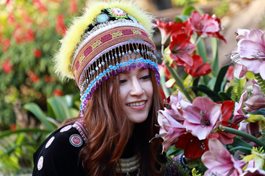
Nestled in the mountain ranges of Thailand's Northern Mountains is the Chiang Mai province, one of Thailand's most colorful and intriguing regions. The most famous inhabitants of Chiang Mai are the Hill Tribes, a loose confederation of peoples who drifted towards the region, seeking refuge from the political persecution they faced in their native Tibet, Laos, China, and Myanmar. Preferring to live at elevations of more than 1000 ft., these tribes scratch out an uneasy subsistence through farming and handicrafts, their fierce independence keeping them from fully integrating and assimilating into mainstream Thai society, both culturally and in terms of enjoying the full rights of Thai citizenship. Far from homogenous, each of the seven main tribes has its own unique cultures, traditions, and customs.
KAREN
The largest of Hill Tribe groups, the Karen inhabit the foothills of mountains, living on the upper floors of homes raised on stilts, the domestic animals they rear, including tame elephants used in farming, inhabit the bottom floor. The Karen are successful farmers, particularly of rice, and are by far the most sophisticated of the Hill Tribes in terms their careful husbandry of the land they till; the Karen practice crop rotation, fertilization, and sophisticated irrigation. They also hunt and are skilled weavers, dyers, and seamstresses. Some, but not all, of the Karen converted to Christianity, though all pay careful attention to the veneration of ancestors.
LAHU
The 73,000 Lahu are divided into five subgroups: Red Lahu, Yellow Lahu, Black Lahu, White Lahu and Lahu Sheleh. Originating from Myanmar, the Lahu are physically larger than the other Hill Tribe people. They are excellent hunters and trappers and highly skilled herbalists, including a history of opium cultivation.
HMONG (also known as the MEO)
Like all of the Hill Tribe peoples, the Hmong value their political and social independence, and went to war on the communist side in their native Laos to seek it. This tribe is the most patriarchal, openly practicing polygamy and sharply dividing work and tradition between the sexes. Visitors to the Hmong prize their intricate embroidery and exquisite silver ornaments, which they wear at special ceremonies.
LISU (also known as the LISA)
The Lisu are originally from Tibet, and fled that occupied land, seeking the freedom to practice their own worship of natural spirits and ancestors. The Lisu settle near the summits of mountains, ideally near a stream or waterfall.
AKHA
The 50,000 Akha currently living in Thailand are the most impoverished of the Hill Tribes peoples, but one of the most fascinating in terms of culture and traditions. Originating from both Tibet and Myanmar, the Akha are distinguishable by their exquisitely carved wooden gates, which they believe house their guardian spirits. They also worship their ancestors and a special room in each dwelling is set aside for this purpose. The Akha are largely illiterate, but have a fascinating oral culture, through which the recall the many generations of ancestors and tribal lore. The Akha women wear quite plain clothing but very ornate headdresses and ornaments.
MIEN (also known as the YAO)
Closest in culture to the Central Chinese, Chiang Mai's 40,000 Mien differ from many of their Hill Tribe neighbors in their sophisticated written language, which enables them to transact business throughout the Hill Tribe community. They live in thick woods found in Thailand’s low hills, and in addition to bartering, buying, and selling, the Mien are skilled silversmiths and metal workers. The women make exquisite embroidered cloth and high quality paper goods.
PADUANG
Possibly the best known of the Hill Tribes, the Paduang differ from their neighbors in that they have always lived in Thailand and thus are not considered ethnic minorities. Their practice of using brass rings to elongate the necks of women has made them famous with tourists, for whom the practice is kept up. In actual fact, the practice forces the collarbone down into the torso rather than elongating the neck.
Meet the Hill Tribes of Northern Thailand on Alexander + Roberts's unique journey
Hill Tribes of Thailand, which also includes visits to Bangkok and the Bridge over the River Kwai. Always capped at 16 guests for your maximum enjoyment.